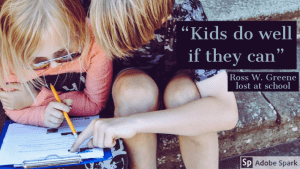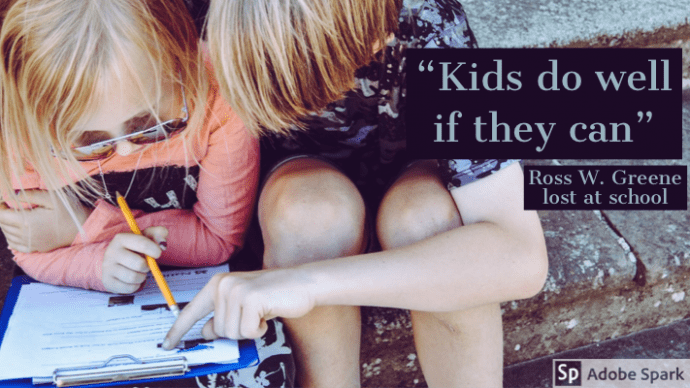This summer, I read Lost At School by Dr. Ross Greene for my Pre-Planning PD Book Club. I definitely recommend this book to all educators or anyone who is working with children (whether it is at summer camp, after school activities, etc). There were many ‘Aha! moments’ while I was reading the book, but the one thing that kept swirling around in my head (and rightfully so, as it is the foundational principle that the entire book is written about) was “Kids do well if they can”.
What does that really mean? The students who get sent to the office for acting out  and flipping desks are incapable of sitting and listening and keeping their desks upright? YES. As educators, we must give the students the tools they need and teach them the lagging skills (more on this later) they need in order to help them be successful. If a kid could do well, he/she would.
and flipping desks are incapable of sitting and listening and keeping their desks upright? YES. As educators, we must give the students the tools they need and teach them the lagging skills (more on this later) they need in order to help them be successful. If a kid could do well, he/she would.
This is a theory that I feel very passionate about. I focused on this with my professional growth plan last year; as I was creating visual tools for students to help with their lagging skills in various areas of executive functioning.
There’s that word again – lagging skills. The book explains that we must truly understand why a child is challenging in order to be able to help them. We must identify the skills they are missing (a.k.a lagging skills) in order to solve the problem (using the CPS model). Some examples of lagging skills are: difficulty with transitions, difficulty maintaining focus, difficulty seeing the “grays”/black-and-white thinking, difficulty empathizing with others. As a new(er) educator, this turned on a lot of lightbulbs for me. Sending a child to the office for a consequence won’t guarantee that the challenging behaviour will stop. However, identifying the lagging skills AND teaching those skills to a child, will solve the problem (and stop the challenging behaviour)!
The book lays out the ALSUP (Analysis of Lagging Skills and Unsolved Problems) in an easy to follow checklist. Now the question is, how do I implement it in my classroom? I had the privilege of working alongside Justin Shulman, an OCDSB Vice Principle, this summer. While we were not in a formal education setting (we were at a sleep-away summer camp), he leaned into the CPS model when helping our camp’s staff work through difficult camper behaviours. I felt like I was getting some hands-on PD as I was reading my book about CPS in the evenings before bed and then observing (and taking part in) using the CPS model with campers throughout the day.
Even with this experience, I still sit here asking myself how can I implement this effectively? Will I be able to identify the lagging skills and unsolved problems for all 23 of my students? Will I be able to teach these lagging skills while covering the rest of the curriculum? Will I be able to solve problems collaboratively with my students like in the examples in the book? These questions make me sound skeptical… TRUST ME, I AM NOT SKEPTICAL! I think shifting to the CPS model will do wonders for the way we teach and grow our students. I am excited to deepen my understanding and gain more hands-on experience with the ideas and theories from this book, but with that comes a small piece of uncertainty (as do most new things). It doesn’t mean I am skeptical, it just means that this is one of the many areas in which I will be learning beside my students this school year.
Here’s a little bonus for you (assuming you’re hopping onto the ‘Lost At School Bandwagon’ with me). Through my PD and online connections via my twitter PLN, I have come across two lovely resources:
- A reading group guide with a variety of discussion questions pertaining to Joey’s story and the theories presented in the book.
- CPS resources for Educators/Schools from Lives in the Balance (a non-profit organization founded by Dr. Ross Greene).
